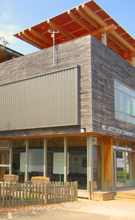|

Shading close up

Hybrid design solutions
|
 |
 |
|
|
|
| The right calculation methodology for the right project stage |
|
Building energy modelling applied as early as possible may reduce most cost effectively energy demand /consumption & environmental impact. Bearing this in mind, specialised consultants should supply design teams ideally from concept stage with a broader understanding of design options and their potential effect on building performance. Unfortunately most existing building simulation tools still focus only on estimating energy profiles of final fully detailed designs requiring a long list of input data.
Timescale constraints and lack of specialised building modellers has currently led to an urge for developing calculation methodologies and relevant software tools suited for different project stages (thus increasing resolution of information only where relevant). The goal is to develop a structured approach regarding the assessment of a variety of energy saving options available (related to the building's shape, shell components, building services and lighting design).
The main concept of such an approach is to identify the project stage in which each particular design parameter should be closer investigated and weighed according to its effect on the building's total energy consumption. Depending on the project stage, resolution of calculation methodologies may vary.
In further detail especially in initial stages of a design, prioritising the various parameters, applying benchmarks dependent on the building type (based on data of existing case studies) and performing some spread sheet calculations should function as main guidance regarding the selection and evaluation of the main aspects of a building.
CIBSE via technical memorandums and British Universities in collaboration with the Building Research Establishment have been involved in statistical analysis of energy data from existing buildings to develop realistic benchmarks and be able to interrogate/improve building models. They have also created simplified methodologies for estimating various energy uses by linking the gathered actual building databases with basic physics equations describing the relevant phenomena.
In further detail:
- TM54 is a new methodology presented by CIBSE in order to estimate as accurately as possible total building energy consumption for specific projects of all levels
- BRE in collaboration with Strathclyde University has focused, regarding the domestic sector, on creating a new standard assessment procedure (SAP) compliant advanced dynamic simulation method (IDEAS - Inverse dynamics based Energy assessment and simulation). | |
|
| |
|
|
|
|
|
|

Is nuclear viable? |
